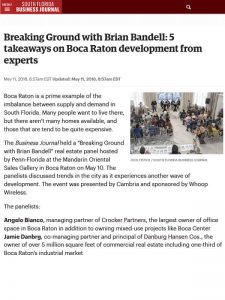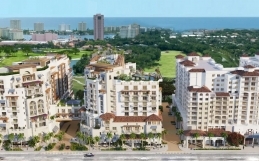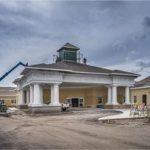Breaking Ground with Brian Bandell: 5 takeaways on Boca Raton development from experts
By Brian Bandell – Senior Reporter, South Florida Business Journal
May 11, 2018, 6:57am EDT Updated May 11, 2018, 8:57am EDT
Boca Raton is a prime example of the imbalance between supply and demand in South Florida. Many people want to live there, but there aren’t many homes available, and those that are tend to be quite expensive.
The Business Journal held a “Breaking Ground with Brian Bandell” real estate panel hosted by Penn-Florida at the Mandarin Oriental Sales Gallery in Boca Raton on May 10. The panelists discussed trends in the city as it experiences another wave of development. The event was presented by Cambria and sponsored by Whoop Wireless.
The panelists:
Angelo Bianco, managing partner of Crocker Partners, the largest owner of office space in Boca Raton in addition to owning mixed-use projects like Boca Center. Jamie Danbrg, co-managing partner and principal of Danburg Hansen Cos., the owner of over 5 million square feet of commercial real estate including one-third of Boca Raton’s industrial market. Ignacio Diaz, director of Group P6, the developer of the 327 Royal Palm condo downtown. Frank Weed, VP of development and construction for Penn-Florida Cos., developer of the Mandarin Oriental and Via Mizner in Boca Raton, among its other holdings in the city.
Here are 5 takeaways from the panel:
Many people work in Boca, not nearly as many live there
Boca Raton is one of the largest employment centers in South Florida, and that can be both good and bad.
The city has many high-paying jobs and high-profile corporate headquarters, such as Office Depot, ADT and Geo Group. The problem is that about 90 percent of the workforce commutes to the city, Bianco said. That causes heavy traffic.
“With all the traffic in the morning, there are people who would love to live here and have a shorter commute,” Bianco said.
Many people would like to live in Boca Raton for its proximity to the workplace, quality schools and universities, and restaurants, Weed said. As a resident of downtown who walks to work, he said living there is convenient.
Bianco said Boca Raton is too expensive for many workers to live, and part of the problem is there aren’t enough homes being developed. This has also made it harder to fill office space, as companies want to be located near where workers can afford homes, he said.
Returning to downtown
People are rediscovering downtown living across South Florida and Boca Raton is no exception. Downtown Boca Raton has a well-established climate for the arts, dining and luxury shopping.
Diaz said many of his condo buyers are moving from country clubs in west Boca Raton or condos near the beach into downtown because they want to live a more active lifestyle.
Weed said all of the buyers at the Mandarin Oriental are from Boca Raton. Many are downsizing from houses after their children moved out and prefer living downtown, he said.
That also goes for seniors. Both Penn-Florida and Group P6 plan to build assisted living facilities in downtown Boca Raton in 375 Royal Palm and the Concierge, respectively. Weed said many people, as they age, want to stay near family and they’re still young enough to be active in a downtown environment.
“The idea that the seniors must live out west in a country club is changing,” Diaz said. “Having seniors makes a downtown more diverse.”
Mixed-use rezoning has been effective
After Boca Raton rezoned the Park at Broken Sound, formerly the Arvida Park of Commerce, to allow for mixed-use with residential, that attracted many developers.
Danburg co-developed the Allure Boca Raton apartments there with Tate Capital. He initially thought the tenants would be mostly young workers, but there are plenty of older renters too. The average household income for his renters is $200,000, Danburg said.
Crocker Partners eventually plans to build retail and residential around the Boca Raton Innovation Campus, which it recently acquired with other partners, Bianco said. Its first order of business will be creating a STEM lab on the property in partnership with the Massachusetts Institute of Technology and Carnegie Mellon, he said.
Right now, much of the land around the BRIC and other parts of the Park at Broken Sound are surface parking lots.
“We can’t have these large dead areas in our city,” Bianco said.
Penn-Florida plans to create a new mixed-use destination in Boca Raton with its 80-acre University Village project just north of Florida Atlantic University. The project would have 829 apartments and assisted living units, an 183-room hotel, 70,000 square feet of office space and 130,000 square feet of retail.
Weed said he plans to break ground on University Village in seven to eight months. It was designed with a main street and an urban feel. People can go downstairs from their apartments to shops and restaurants, and there will be a pickup area for ride-sharing, he said.
Bianco was hoping the city would approve a 300-acre area around the Town Center mall as a new mixed-use district with another 2,500 residential units. That plan hasn’t been approved and Crocker Partners has threatened to sue the city for $137 million in damages.
Bianco said the new homes would actually reduce traffic because there would be fewer long-range commuters.
Office space taking longer to bounce back
The vacancy rate for office space in north and west Boca Raton remains in the double digits, and above the Palm Beach County average.
The unemployment rate is very low, but companies are housing more employees per square foot of office space, Danburg said. Plus, advanced technology means companies can eliminate some workers, such as personal assistants, he said.
Danburg would like to see the city do more to attract new businesses to the area.
Weed said Penn-Florida is designing the new offices at University Village for modern-day companies, with smart technology features and space suitable for co-working.
Boca residents love their restaurants
The retail vacancy rate in Boca Raton is among the lowest in South Florida, and the local appetite is a big reason why.
Bianco said that the restaurant sales in the area between Glades Plaza and J. Alexander’s alone surpass the restaurant sales for the entire city of Delray Beach.
“Nobody in Boca Raton cooks,” Bianco said. “They buy expensive food in the grocery market, then they go out and eat.”
Danburg said retail and restaurants do well in Boca Raton because people have higher incomes and they have more leisure time.






